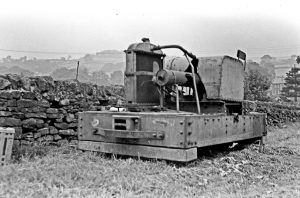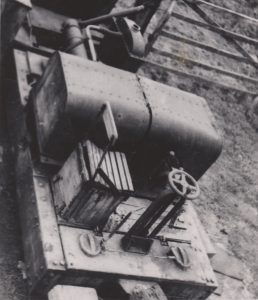‘BRADFIELD’.
F C Hibberd Ltd, Works Number 1777, 4 Wheel Petrol Locomotive.
Formerly used at Sheffield Corporation Waterworks, Low Bradfield.
This locomotive is of the ‘Simplex’ type fitted with a 20HP, Dorman 2JOR two cylinder, petrol engine. This ‘Simplex’ design was a very successful one, developed by the Motor Rail & Tramcar Co Ltd for the British Army in World War 1. The ‘Simplex’ design, is a simple and quite novel one which lasted a very long time with the Motor Rail Company. The design features the engine and gearbox mounted transversely across the centre of the locomotive with drive chains linking directly from the gearbox drive sprockets to sprockets on the locomotive axles. It is interesting that many cars adopted this layout of engine and gearbox from the 1950s onwards.
After the War a large number of these ‘Simplex’ locomotives (many brand-new and unused) were sold off. A number were re-purchased by Motor Rail and sold on by them to customers, whilst many others were bought by two, associated companies: Honeywill Brothers Ltd and Kent Construction and Engineering Co Ltd (both of Ashford) who reconditioned them for resale as ‘Planet-Simplex’ locomotives.
In 1926 two of the Honeywill directors bought the stock of remaining locomotives of the Kent Construction and Engineering and established a new company F C Hibberd & Co Ltd, continuing to market locomotives under the ‘Planet’ brand name. Many early Hibberd locomotives were built by Bedford Engineering, a company who had also built locomotives for Motor Rail. On the demise of Bedford Engineering, Hibberd established their own factory in 1932 on the then rapidly developing Park Royal Industrial Estate to the north west of London.

The locomotive in 1970, soon after arrival at Hesketh Bank
This Hibberd locomotive was built by Bedford Engineering in 1931 as one of Hibberd’s ‘Planet-Simplex’ type locomotives. Rather than being a re-engineered Motor Rail locomotive. It was a new Hibberd locomotive. The locomotive differs from Motor Rail ‘Simplex’ locomotives in that it has a large, rectangular frame, the side members of which are quite deep and obscure the axleboxes and locomotive running gear. The design featured large cast iron ballast weights below the ends of the frame which gave the locomotive a weight in working order of 3½ tons.
Around this time, Hibberd introduced a series of locomotives with a more conventional layout of engine and gearbox (longitudinally along the axis of the locomotive). These were initially based on designs by the old-established firm of agricultural and light railway engineers, J & F Howard, whose designs and stock Hibberd acquired when that company closed down in 1932. Hibberd offered these alongside their own ‘Simplex’ type locomotives and some rebuilt Motor Rail locomotives. Hibberd continued to develop their locomotive designs and manufactured narrow gauge and smaller standard gauge locomotives successfully until the market contracted in the late 1950s. They closed their Park Royal factory in 1963 and the Company was sold to the Butterley Engineering Company.
This locomotive was one of four built for Sheffield Corporation Waterworks for use in connection with construction and maintenance work on their numerous dams and water treatment works in the Pennines to the west of the City. They were delivered to Deepcar station which was the closest station to the reservoirs. The order for the locomotives was placed through the major industrial and construction plant dealers: Thomas W. Ward of Albion Works, Sheffield, whose plates were affixed to the sides of the locomotives.
The locomotive latterly worked at Low Bradfield, a picturesque location central in a series of reservoirs including Dale Dyke, Agden and Damflask. It remained there until the railway system fell into disuse in the late 1960s. At Sheffield, the locomotive was painted dark green. It was acquired for preservation through the good offices of narrow gauge railway enthusiast, the late Andrew Wilson and moved to the West Lancashire Light Railway in November 1970 along with a skip wagon chassis; one of the two remaining items of rolling stock from this railway.
This interesting locomotive is complete and still has its original Dorman petrol engine. Not currently in running order it awaits some mechanical repair work. It has been given the name ‘Bradfield’, but this is not actually carried by the locomotive, and is in storage at Hesketh Bank.


